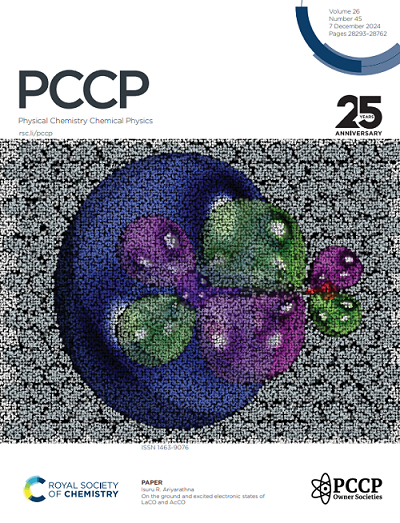Unitary coupled-cluster theory for the electron propagator: electron attachment and physical properties via the intermediate state representation
IF 2.9
3区 化学
Q3 CHEMISTRY, PHYSICAL
引用次数: 0
Abstract
A scheme for the calculation of electron-attachment (EA) processes within the framework of unitary coupled-cluster (UCC) theory is presented. Analogous to the description of electron-detachment, the intermediate state representation (ISR) approach is used for the formulation and its relation to the algebraic-diagrammatic construction scheme is pointed out. Due to the UCC ansatz, the resulting equations cannot be given by closed-form expressions, but need to be approximated. Explicit working equations for two computational schemes referred to as EA-UCC2 and EA-UCC3 are given, providing electron-attachment energies and spectroscopic amplitudes of electron-attached states dominated by one-particle excitations correct through second and third order in perturbation theory, respectively. In the derivation, an expansion of the UCC transformed Hamiltonian involving Bernoulli numbers as expansion coefficients is employed. In a benchmark against full configuration interaction (FCI) results including 50 states of 21 different species, both neutral and charged, closed- and open-shell, the novel methods are characterized by mean absolute errors of 0.15 eV (EA-UCC2) and 0.10 eV (EA-UCC3). Furthermore, an approach for the computation of physical properties of electron-attached as well as electron-detached states within the UCC framework is presented. It also builds upon the ISR approach, featuring an expectation value-like formulation similar to that of the equation-of-motion coupled-cluster (EOM-CC) method or the ISR approach of the algebraic-diagrammatic construction (ADC) method. Explicit expressions for the expectation value of a general one-particle operator correct through second order in perturbation theory are given and shown to be equivalent to those of the second-order ADC/ISR procedure.电子传播体的单一耦合簇理论:通过中间态表示的电子附着和物理性质
提出了一种在统一耦合簇理论框架下计算电子附着过程的方法。与电子分离的描述类似,本文采用中间态表示(ISR)方法,并指出其与代数图解结构方案的关系。由于UCC的存在,得到的方程不能用封闭形式的表达式给出,而需要进行近似。给出了EA-UCC2和EA-UCC3两种计算格式的显式工作方程,分别通过二阶和三阶摄动理论给出了单粒子激励主导的电子附着能和光谱振幅。在推导中,采用了以伯努利数为展开系数的UCC变换哈密顿量的展开。在全构型相互作用(FCI)的基准测试中,该方法的平均绝对误差分别为0.15 eV (EA-UCC2)和0.10 eV (EA-UCC3)。此外,还提出了一种在UCC框架内计算电子附着态和电子分离态物理性质的方法。它还建立在ISR方法的基础上,具有类似于运动方程耦合簇(EOM-CC)方法或代数图构造(ADC)方法的ISR方法的期望值式公式。给出了在微扰理论中二阶修正的一般单粒子算子期望值的显式表达式,并证明了其等价于二阶ADC/ISR过程的表达式。
本文章由计算机程序翻译,如有差异,请以英文原文为准。
求助全文
约1分钟内获得全文
求助全文
来源期刊

Physical Chemistry Chemical Physics
化学-物理:原子、分子和化学物理
CiteScore
5.50
自引率
9.10%
发文量
2675
审稿时长
2.0 months
期刊介绍:
Physical Chemistry Chemical Physics (PCCP) is an international journal co-owned by 19 physical chemistry and physics societies from around the world. This journal publishes original, cutting-edge research in physical chemistry, chemical physics and biophysical chemistry. To be suitable for publication in PCCP, articles must include significant innovation and/or insight into physical chemistry; this is the most important criterion that reviewers and Editors will judge against when evaluating submissions.
The journal has a broad scope and welcomes contributions spanning experiment, theory, computation and data science. Topical coverage includes spectroscopy, dynamics, kinetics, statistical mechanics, thermodynamics, electrochemistry, catalysis, surface science, quantum mechanics, quantum computing and machine learning. Interdisciplinary research areas such as polymers and soft matter, materials, nanoscience, energy, surfaces/interfaces, and biophysical chemistry are welcomed if they demonstrate significant innovation and/or insight into physical chemistry. Joined experimental/theoretical studies are particularly appreciated when complementary and based on up-to-date approaches.
 求助内容:
求助内容: 应助结果提醒方式:
应助结果提醒方式:


